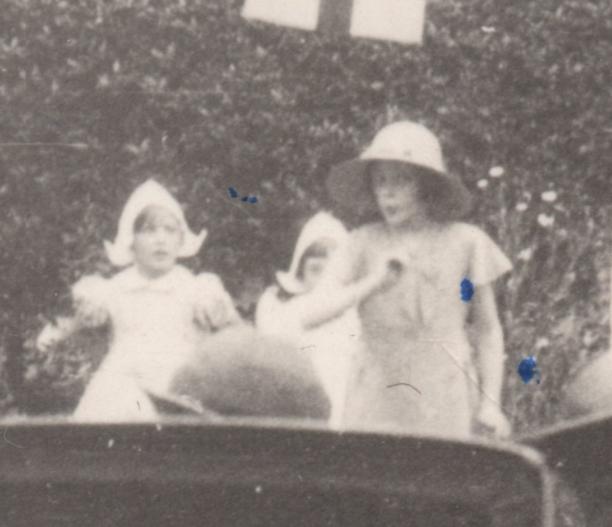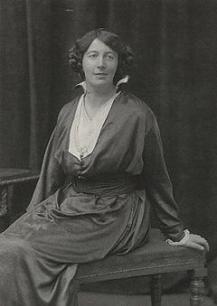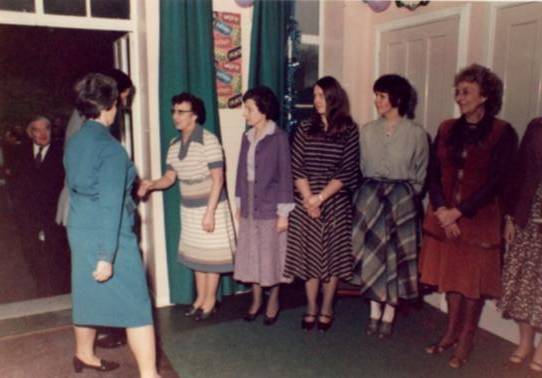Miss Lowe
I was born on November 17th 1924, at a house called Hill Croft, in Coed Richard, Acrefair. My father was manager at Wynnstay Colliery at that time. Later he left the mining industry and went in for civil engineering with the firm of Whitley Bros. At this time we lived inRhyl. We moved up to Yorkshire, where my father was in charge of a road building scheme, where they were experimenting with re-inforced concrete instead of tarmacadam for road surfacing. We left Yorkshire when my father took a post with Denbighshire County Council, Roads and Bridges Department, with which he worked until his retirement. During the latter years we lived in Rossett and Marchwiel and finally Llangollen.
William Lowe with a young Betty, at the Baptist Chapel, Caernarvon.
While my father, William Lowe, was the manager at Wynnstay Colliery he met my mother Gwendoline Evans, at a dance at the Hand in Llangollen, while she was here staying with her older sister who lived at Ormonde House.
Taid Evan Evans, was a surveyor/architect and it was he who designed the King’s Bridge- not an easy enterprise as it went over canal and river and under the railway.
After attending a number of local schools as the family moved, I went as a day pupil to the convent in Wrexham and eventually to boarding school, just outside Denbigh. (My mother and Aunts had previously attended Wellington Ladies’ College as boarders) Great grandmother and great grandfather lived at Dee Villa.
Our house in Rawcliffe
At about 10 years old-- to quote "Doing my stuff" at a vicarage garden party in Rawcliffe, Yorksire.

A closer look
It was in Yorkshire that I,at ten years old, was christened.My grandmother was a baptist, so no action had been taken whilst I was a baby, but due to a close friendship with our neighbour in Yorkshire, the local vicar, the christening took place there.
As a child, I read almost anything I could lay my hands on, and at boarding school too, where a child was only allowed to listen to the radio for half an hour on a Saturday and Sunday evening. I always waited with anticipation the big "Girls Own Annual" I recieved each year at Christmas. When in the Yorkshire village I made full use of the local travelling library. My father always read to me on a Sunday while I was at home – books like Water Babies and Lorna Doone. And it was probably from him that I developed such a love of books.
Berta Ruck, a great friend of my mother and her sisters.. She took my mother and one of her sisters under her wing when they came up to do war work in London. My mother was at the India Office and Her sister at the Ministry of Munitions.
 "(Amy
Roberta (Berta) Ruck (2 August 1878 - 11 August 1978)[
was a romantic novelist, writing almost eighty novels over the course of her
writing career as well as large numbers of short stories. From 1905 Ruck began
to contribute short stories and serials to magazines. Ruck published her first
novel, His Official Fiancée in 1914. Ruck also wrote an autobiography
and two memoir-style works. She was born in India, the daughter of an army
officer and one of eight children. The family moved to Wales where Ruck went to
school in Bangor and married novelist Oliver Onions in 1909 and they had two
sons, Arthur (born 1912) and William (born 1913). Examples of her books are
His Official Fiancée (1914) - filmed twice: 1919 (silent) and 1944
(Swedish) The Wooing of Rosamund Fayre (1914) The Bridge of Kisses
(1917) The Girl who Proposed (1918) Lucky in Love (1924). She
lived to be 100 years old.
A number of
her books were autobiographical and set in Wales; one of the best known of these
is "Ancestral Voices"
"(Amy
Roberta (Berta) Ruck (2 August 1878 - 11 August 1978)[
was a romantic novelist, writing almost eighty novels over the course of her
writing career as well as large numbers of short stories. From 1905 Ruck began
to contribute short stories and serials to magazines. Ruck published her first
novel, His Official Fiancée in 1914. Ruck also wrote an autobiography
and two memoir-style works. She was born in India, the daughter of an army
officer and one of eight children. The family moved to Wales where Ruck went to
school in Bangor and married novelist Oliver Onions in 1909 and they had two
sons, Arthur (born 1912) and William (born 1913). Examples of her books are
His Official Fiancée (1914) - filmed twice: 1919 (silent) and 1944
(Swedish) The Wooing of Rosamund Fayre (1914) The Bridge of Kisses
(1917) The Girl who Proposed (1918) Lucky in Love (1924). She
lived to be 100 years old.
A number of
her books were autobiographical and set in Wales; one of the best known of these
is "Ancestral Voices"
Her husband, well-known ghost story writer Oliver Onions (1873-1961), wrote many such books, but one in particular - "The Beckoning Fair One" - is apparently considered by many to be the best ghost story ever written"(Wikipedia)
Even when away from Llangollen, I never truly lost contact as I maintained connection with regular visits to my Aunt Jess at Ormond House in Llangollen. My uncle was Mr Alfred Williams, the dentist.
Although I was an only child, I was part of a large extended family. Each of my parents was one of six. At one time I had 21 first cousins. My grandparents on my father’s side came from Coppull, Lancashire and I loved to visit them.
On leaving school I attended a Housekeepers Course at the FL Calder College of Domestic Science, Myrtle Street, Liverpool. This was my father’s idea as he thought that I could use my acting skills to become a demonstrator.
I never did use the skills learned at college as a career, as I was called home to look after my mother who was ill, but I did continue with the acting at which it appears I had shown promise right from an early age. I attended Miss Kathleen Jones locally for speech and drama lessons and went to London once a week to work under Rose Bruford- the then Principle of the Drama Department of the Royal Academy of Music.
This acting ability appears to have come from my father who in the 1920’s came to Llangollen, for the Mine Managers job, (having already performed with Wigan Operatic Society) and joined the Llangolllen Operatic Society.

This photo was taken when I was head of the Drama Department at Howell’s School, Denbigh when the Prince of Wales came to visit the school.
He produced a number of their operas and took part in many of the performances in the 1920’s. Apparently even in those days my mother commented that she was left home alone night after night looking after me, while he was busy with rehearsals. (Very much the same story today!)
The acting group was started by Scott Archer. He knew about William Lowe, so that when the family returned to the Llangollen area, my father was immediately approached and asked to join and pointed out that I was also a keen actress, and so the two of us became involved. The first performance over, and with 20 members, the group was given the name 20 club. I was in the first play and many of the following productions, of which there were two or three a year. We used to compete in the Wrexham Drama festival and won several times. I became very involved with the productions of the 20 Club and even would stand in for my father, on occasion, to take rehearsals for the operatic Society, if he was not available- but I have no musical skills.
A close friend, Mrs Rhys Thomas taught Sylvia Bailey and I to play bridge. Mr Rhys Thomas was the church organist and would conduct the orchestre for the operatic Society’s shows. My father was very good in musicals with the chorus movements.
As well as looking after my Mother, I taught drama at Llantyslio for Miss Grace Lloyd Williams and also taught Drama and elocution, one day a week at Rhug, when a School from Harrogate was evacuated there during the war.
(Jill and Barbara Bowen of Siambr Wen (vets) remember fondly having to repeat
"Miss Lowe rows in a boat, in a scarlet coat, (in order to improve their "O" sound.)
The War Years.
I was heavily involved with the responsibility of caring for my increasingly dependant mother during the war, so did remain at home. In this period we made our home at Berwyn at our house, Holmwood.
A first cousin (Father’s side) was in the Dambuster squadron and although not on the dambuster raid and was a navigator on the raid which sank the German battleship, Turpitz. I believe he was given the DFC for this.
Father was in the Royal Engineers and he was moved to one of the Royal Engineers Tunnelling companies (there was a great need for mining experts.) He told me that "It was a strange sensation to be tunnelling towards an enemy trench and to hear the enemy’s picks sounding from the opposite direction".
He remembered being on a short break and being on the launch belonging to the Colman’s Mustard family. He was on the deck when a scarecrow of a man approached him. He duly recognised his own younger brother, who was fed, clothed and returned to his regiment. In the First World War, my mother’s only brother was one of the first to be wounded. He received an artificial leg and went on, when well, to become adjutant of the Royal Engineers at Chatham
When he was wounded he was sent to London to a nursing home set up by Agnes Keyser (1852 – 1941 in her own home) and it was due mainly to her strict " don’t give way" and "no bent walking now" approach that he managed his artificial limb so well.
She was the wealthy daughter of a Stock exchange member, a humanitarian, courtisan and longtime mistress of Edward V11. She remained with Edward VII until his death in 1910.King Edward VII’s Hospital for Officers was established in 1899 by two sisters, Agnes and Fanny Keyser, who turned their home at 17 Grosvenor Crescent into a hospital for sick and wounded Officers. Returning from the war, King Edward VII became the Hospital’s first patron. Agnes Keyser had become involved with Edward VII around that time, and their relationship would continue until his death. With the encouragement of King Edward VII, together with Agnes Keyser’s enthusiasm, immense support was received from the individuals who later became known as Friends. Over 4,000 Friends pledge their support to the Hospital to this day. Sister Agnes (as she became known) and her staff continued to care for Officers in peacetime. She was renowned for her devoted service to the Hospital, her kindness, tact and firm, effective but inherently caring management.The Hospital moved to its present site in Beaumont Street in 1948, when it was officially opened by Her Majesty Queen Mary. In 2000 the Hospital changed its title to King Edward V11 Hospital Sister Agnes and more recently, in accordance with a charitable aim, the financial benefits to which Officers had been entitled, were conditionally extended to all ranks of ex-Service personnel. (Wikipedia)
I remember loving the outings with my father to visit the colliery horses at Coppull- a village where they were kept. Granny told me about the early days of mining when even young children were sent down the pits. One of their jobs was to push open the doors underground.
The Wynnstay ponies would be sent to the hills for holidays and, before I was born, my father would borrow a saddle so that his nieces and nephews could have a ride.
My grandmother could remember groups of miners standing on street corners together, so that the one who had learned to read could read from the newspaper to those who could not.
I remember playing in an old horse drawn ambulance in the stables at Coppull. (My father’s old home) and hearing about someone being sent to pick up some pork pies from a lady who baked them for sale and seeing her sticking down the lids with" spit. No more pies were bought from her! Christmas day usually saw a very large number of people sitting down to eat. I remember a huge dog kennel and the two dogs, a spaniel and a setter. It was an exciting house to a child- full of corridors and empty rooms. There was a wardrobe large enough to hide in and a dolls’ china teaset to play with.
I bought my present cottage from Clare Littleboy- one of the early potters at Llangollen Pottery, who used to throw pots in the yard at Eisteddfod time. Their main pottery was on Regent Street.
I do not think the house had always been a canal cottage, unlike the cottage at Berwyn which always housed a canal worker.
Initially the house was probably only two rooms downstairs and a single attic room upstairs. It appears to date back to the late 18h or early 19th century.
My uncle, Trevor, (Lloyd Jones), used to tell me that at one time there was a large wheel, just above the cottage and that a large woman used to work this wheel, so that by attaching a rope/chain to the back of horse-drawn drays they could be assisted in their descent down the steep and cobbled Wharf Hill with their heavy loads off the canal boats.
Visible in the near past, but covered when my yard was tarmaced, was a clear outline of the former weigh-bridge. It does appear that loads to and from the canal barges were weighed here. The small out-house stll contains a fireplace- and was probably used to give shelter to the weigh bridge operator.
My family were not all Welsh speakers, and though my mother‘s parents had spoken Welsh, my mothers’ Welsh was very rusty.
Currently, I remain involved in life in Llangollen, being a member of the Civic society and Hanes and the 20 club of which I am a founder member.
I spend time each day taking Fergie, my King Charles spaniel for his regular walks.
I do believe that it is important for people of my generation to remain as active as possible.